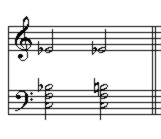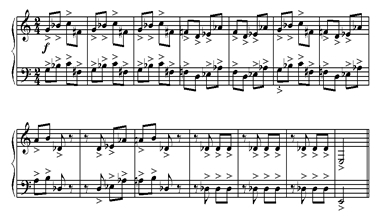General Principles of Harmony – Movement, Interest, and Variety
GENERAL ASPECTS OF HARMONIC ACCENT
Music whose only virtue is coherence is simply boring. If a piece is to hold the listener’s attention throughout, it requires both continuity and various contrasts. These contrasts come in varying degrees, normally in proportion to the length of the piece: The longer the piece, the more novelty is needed. Varying the music’s contour, giving it highs and lows, makes it breathe, and creates an organic sense of tension and release.
Renewal of interest operates on all time scales: locally and across the whole work. It always involves novelty: something different from the preceding norm. (Note that novelty can also result from putting something familiar in a new context.) Novelty creates musical “questions” and thus becomes propulsive: It first attracts the listener’s attention, and then calls his previous expectations into question.
In general terms, such questions, or accents, involve one or more the following:
- rhythmic stress.
- change in the level of harmonic tension (e.g. dissonance, in a classical context).
- different density of texture.
- change in register.
- new timbre(s).
CREATING MOMENTUM AND RENEWING INTEREST ON VARIOUS STRUCTURAL LEVELS
Locally
On a local level, the following elements are propulsive:
- Active tones in scales or modes: As mentioned previously, in any unequal scale some notes are more active than others. These notes create instability, pushing the music forward. (This is one reason why music which relentlessly exploits the total chromatic scale, especially if there is no particular tonal focus, quickly becomes gray and uninteresting.) Active tones modulate the level of harmonic tension.
- Unequal intervals within chords: If all of the intervals in a chord are equidistant, the effect is static, ambiguous. Familiar examples include the diminished 7th chord and the augmented triad (both of which, incidentally, are extreme cases, since even when piled up beyond a single octave they introduce no new notes, unlike, say, a stack of 4ths). Unequal intervals create tension and momentum. Note, however, that if the number of different intervals becomes too great, and especially if the spacing includes multiple, adjacent sharp dissonances, the chord will tend to “clot” (Persichetti’s term), bogging down the harmony, since no clear focus of tension can be discerned to suggest subsequent direction.

The first chord here is neutral in direction, due to the stacked perfect 4ths. The second chord is much less stable, due to one single “outlier” (B natural), which engenders a variety of stronger intervallic tensions with the other notes.
- Leaps: Since conjunct motion is the norm for both singing and hearing, a leap is a special event. Even in situations where leaps abound, larger leaps will stick out. Also, the physical effort required to produce them in voices and on most instruments subtly inflects the rhythm.
- Compound lines: Leaping regularly between two or more registers, such lines compress multiple strands of voice-leading into one continuous line. Such lines keep the listener is a constant state of tension, because there is usually at least one strand unresolved.
Higher Levels
On higher levels, the following harmonic elements contribute to interest and momentum: harmonic rhythm, and modulation. These require discussion in more detail.
Harmonic rhythm
By “harmonic rhythm” we mean the rate at which chords change, especially when the outer voices move (N.B.: This is independent of the surface rhythmic values, which may include harmonically static repeated notes and trills). Harmonic rhythm determines how much new pitch information the brain must process in a given time. Even in textures where there is no simple harmonic norm, the rate of arrival of new pitches powerfully affects the music’s momentum.
However, harmonic rhythm is usually felt in relation to a norm; once this norm is established, all other things being equal, faster changes “raise the temperature”, while slower changes seem calmer. Of course arbitrary changes are also possible, but they quickly lose their novelty, since the listener cannot develop meaningful expectations about their continuation. That said, a change from irregular harmonic rhythm to more regular harmonic rhythm, or vice versa, can create a sense of structural movement.

This example (already discussed in another context) plays on the listener’s expectations of harmonic rhythm. The first three, repeated, measures create a sense of stability, which is disrupted by the new notes in the fourth measure. The return to the opening pattern suggests a repeat of the process, but there quickly follows even more novelty. Finally, the return of stability with the repeated C#’s makes the sudden arrival of the final E more dramatic.
One last point: Consistency of harmonic rhythm can help unify the music within a section, while change in harmonic rhythm can help to define differences between sections.
Modulation and Harmonic Transition
In music with clear tonal centers, moving to new tonal regions for contrast is an obvious way to underline structural articulations. It is also a very useful means of creating contrast, since it allows for everything from mild local changes to strong long term shifts.
In music without clear tonal centers, modulation acts like a simple extension of harmonic rhythm: the arrival of new pitches is easily noticed, and the rate of their arrival influences the sense of musical momentum. Even in non-tonal situations one can create gradations of modulation, simply by controlling the number of new notes which arrive within a given span of time. The example above again provides a clear illustration of this process.
Technically, the process of modulation is the harmonic side of the art of transition. As in other aspects of musical form, transitions can be sudden or gradual, and can lead to closer or more remote contrasts.
A useful procedure for planning modulation is:
- Determine the appropriate degree of contrast for where one is in the form.
- Determine whether a gradual or a more abrupt change is required; abrupt changes occur more rarely than gradual ones, since they are more disruptive to the music’s flow.
- Bring in new notes in ways which attract the ear: as accented notes, peaks, resolutions of suspensions, etc. Create momentum towards these new notes with melodic, rhythmic, or textural progressions.
- The more gradual the change required, the more important it is to introduce new notes one at a time.
Note that changing the rate of modulation (an extension of the notion of harmonic rhythm) can also create effects of increased or decreased musical movement. As discussed in our book on musical form, incremental progressions – e.g. in the rate of modulation – allow the composer to create expectations. Such expectations, both fulfilled and unfulfilled, connect the musical present and future to remembered events in the past in a pseudo-causal way, thereby unifying larger stretches of music, through suspense.
Where the music uses such progressions, whether in the rate of modulation or in other aspects of the music, a sense of direction will result. Where there is direction, there will also be climax, i.e. a sense of culmination and arrival. Such climaxes are outstanding moments, which the listener will remember.
